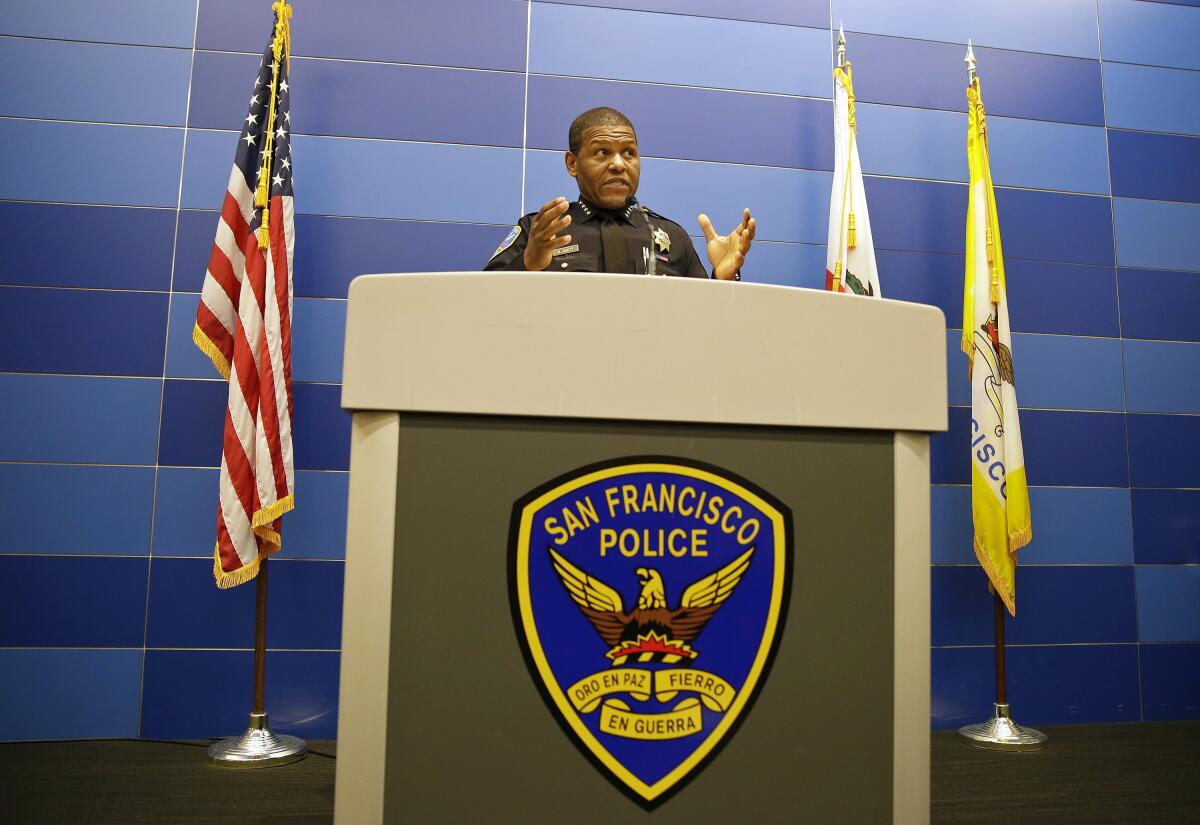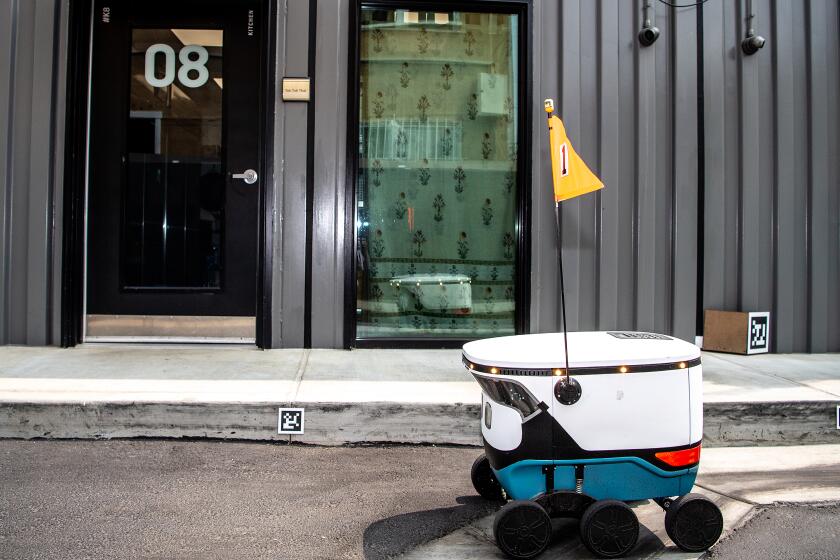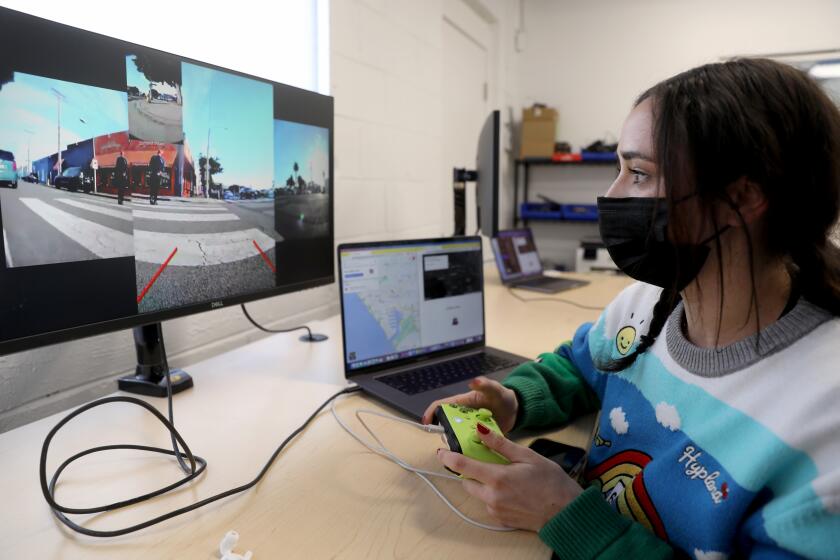San Francisco supervisors vote to allow police to deploy robots that kill

- Share via
SAN FRANCISCO — Supervisors in San Francisco voted Tuesday to grant city police the power to use potentially lethal remote-controlled robots in emergency situations, following an emotionally charged debate that reflected divisions on the politically liberal board over support for law enforcement.
The vote was 8-3, with the majority agreeing to grant police the option despite strong objections from civil-liberties and police-oversight groups. Opponents said the authority would lead to the further militarization of a police force already too aggressive with poor and minority communities.
Supervisor Connie Chan, a member of the committee that forwarded the proposal to the full board, said she understood concerns over use of force but that, “according to state law, we are required to approve the use of these equipments. So here we are, and it’s definitely not a easy discussion.”
The San Francisco Police Department said it does not have pre-armed robots and has no plans to arm robots with guns. But the department could deploy robots equipped with explosive charges “to contact, incapacitate, or disorient [a] violent, armed, or dangerous suspect” when lives are at stake, police spokesperson Allison Maxie said in a statement.
“Robots equipped in this manner would only be used in extreme circumstances to save or prevent further loss of innocent lives,” she said.
Supervisors amended the proposal Tuesday to specify that officers could deploy robots only after using alternative force or de-escalation tactics or concluding that they would not be able to subdue the suspect through those alternative means. Only a limited number of high-ranking officers could authorize use of robots as a deadly-force option.
A new one-step method for 3-D printing allowed UCLA researchers to create robots that can walk, jump and sense their surroundings.
San Francisco police currently have a dozen functioning ground robots used to assess bombs or as eyes in low-visibility situations, the department says. They were acquired between 2010 and 2017, and not once have they been used to deliver an explosive device, police officials said.
But explicit authorization was required after a new California law went into effect this year requiring police and sheriffs departments to inventory military-grade equipment and seek approval for its use.
The state law was authored last year by San Francisco City Atty. David Chiu while he was an Assembly member. It is aimed at giving the public a forum and voice in the acquisition and use of military-grade weapons that have a negative effect on communities, according to the legislation.
A federal program has long dispensed grenade launchers, camouflage uniforms, bayonets, armored vehicles and other surplus military equipment to help local law enforcement.
Pandemic brought home to managers the high cost of unforeseen disruptions, so they are turning more to automation.
In 2017, then-President Trump signed an order reviving the Pentagon program after his predecessor, President Obama, curtailed it in 2015, triggered in part by outrage over the use of military gear during protests in Ferguson, Mo., after the shooting death of Michael Brown.
San Francisco police said late Tuesday that no robots were obtained from military surplus, but some were purchased with federal grant money.
Like many places around the U.S., San Francisco is trying to balance public safety with treasured civil rights such as privacy and the ability to live free of excessive police oversight. In September, supervisors agreed to a trial run allowing police to access private surveillance camera feeds in real time in certain circumstances.
Debate on Tuesday ran for more than two hours, with members on each side accusing the other of reckless fear-mongering.
Delivery robots seem to be everywhere these days. Keeping them out of trouble are human minders who might need to hop on a bike to finish the delivery themselves.
Supervisor Rafael Mandelman, who voted in favor of the policy authorization, said he was troubled by rhetoric painting the police department as untrustworthy and dangerous.
“I think there’s larger questions raised when progressives and progressive policies start looking to the public like they are anti-police,” he said. “I think that is bad for progressives. I think it’s bad for this Board of Supervisors. I think it’s bad for Democrats nationally.”
Board President Shamann Walton, who voted against the proposal, pushed back, saying it made him not anti-police but “pro-people of color.”
“We continuously are being asked to do things in the name of increasing weaponry and opportunities for negative interaction between the police department and people of color,” he said. “This is just one of those things.”
News Alerts
Get breaking news, investigations, analysis and more signature journalism from the Los Angeles Times in your inbox.
You may occasionally receive promotional content from the Los Angeles Times.
The San Francisco Public Defender’s office sent a letter Monday to the board saying that granting police “the ability to kill community members remotely” goes against the city’s progressive values. The office wanted the board to reinstate language barring police from using robots against any person in an act of force.
On the other side of the San Francisco Bay, the Oakland Police Department dropped a similar proposal after public backlash.
The first time a robot was used to deliver explosives in the U.S. was in 2016, when Dallas police sent in an armed robot that killed a holed-up sniper who had slain five officers in an ambush.
More to Read
Sign up for Essential California
The most important California stories and recommendations in your inbox every morning.
You may occasionally receive promotional content from the Los Angeles Times.













